Digital Poster
Higher Field, Higher Resolution & Faster Imaging I
ISMRM & ISMRT Annual Meeting & Exhibition • 03-08 June 2023 • Toronto, ON, Canada

| Computer # | |||
|---|---|---|---|
4071.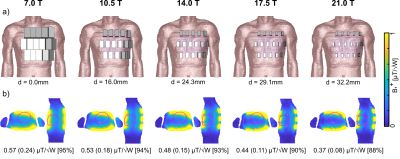 |
141 |
En Route to Body and Cardiac MRI at 21.0 T: Where does the RF
power dissipate?
Bilguun Nurzed1,
Dennis Hieronymi1,
Thomas Wilhelm Eigentler1,
and Thoralf Niendorf1,2,3
1Max-Delbrück Center for Molecular Medicine in the Helmholtz Association, Berlin, Germany, 2Experimental and Clinical Research Center (ECRC), a joint cooperation between the Charité Medical Faculty and the Max-Delbrück Center for Molecular Medicine, Berlin, Germany, 3MRI.TOOLS, Berlin, Germany Keywords: RF Arrays & Systems, Bioeffects & Magnetic Fields Investigation of the power correlation matrix at 21.0 T is vital to elucidate the electrodynamics for human body and cardiac MR as well as the RF antenna performance. Recognizing this opportunity, this abstract assesses the power losses for multi-channel RF transceiver arrays for human body and cardiac MR using 32-channel pTx/Rx self-grounded bow-tie building block (SGBT). Losses were determined inside the tissue, lossy material of the antenna, lumped elements of the tuning and matching network and due to coupling and radiation. |
|
4072.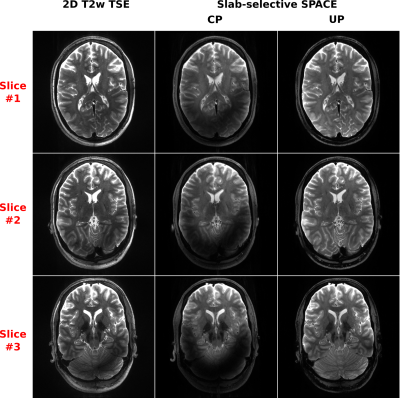 |
142 |
Design of calibration-free RF pulses for T2-weighted single-slab
3D turbo-spin-echo sequences at 7T utilizing parallel
transmission
Daniel Löwen1,
Eberhard Daniel Pracht1,
Vincent Gras2,
Aurelien Massire3,
Franck Mauconduit2,
Nicolas Boulant2,
and Tony Stöcker1,4
1German Center for Neurodegenerative Diseases (DZNE), Bonn, Germany, 2Université Paris-Saclay, Commissariat à l’Energie Atomique, CNRS, NeuroSpin, BAOBAB, Gif sur Yvette, France, 3Siemens Healthineers, Saint-Denis, France, 4Department of Physics and Astronomy, University of Bonn, Bonn, Germany Keywords: High-Field MRI, RF Pulse Design & Fields, Brain, Parallel Transmit & Multiband Multi-Slice T2-weighted MR imaging is a fundamental technique in brain imaging but suffers from field inhomogeneities at ultra-high field systems. In this work we present a pulse design method which provides slab-selective universal pulses with phase-coherent excitation profiles over selected brain regions. Applied in a 3D variable flip angle turbo-spin-echo (TSE) sequence, the pulses achieve superior SNR compared to multi-slice TSE imaging and B1+ field inhomogeneity mitigation. |
|
4073.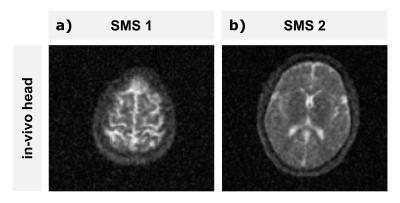 |
143 |
Simultaneous multi-slice 23Na imaging using radial CAIPIRINHA
Marco L. Wittrich1,2,
Armin M. Nagel1,3,
Sebastian Schmitter1,4,
Peter Bachert1,2,
Mark E. Ladd1,2,5,
and Fabian J. Kratzer1,2
1Medical Physics in Radiology, German Cancer Research Center (DKFZ), Heidelberg, Germany, 2Faculty of Physics and Astronomy, University of Heidelberg, Heidelberg, Germany, 3University Hospital Erlangen, Institute for Radiology, Friedrich‐Alexander‐Universität Erlangen‐Nürnberg (FAU), Erlangen, Germany, 4Physikalisch-Technische Bundesanstalt (PTB), Braunschweig and Berlin, Germany, 5Faculty of Medicine, University of Heidelberg, Heidelberg, Germany Keywords: High-Field MRI, Non-Proton, 23Na,SMS,radial CAIPIRINHA In this work, a simultaneous multi-slice (SMS) approach using radial CAIPIRINHA was implemented for sodium MRI. Initial experiments were confined to two simultaneously excited slices. Here, simulated and measured slice profiles agreed well with expectations. Further, the SNR of the acquired SMS images was analyzed and compared to reference measurements of the individual slices. An SNR increase of up to 38% when maintaining flip angle and up to 13% for constant SAR was observed. Lastly, in-vivo head images (2.9x2.9x12mm3) were obtained showing the feasibility of 23Na SMS MRI. |
|
4074.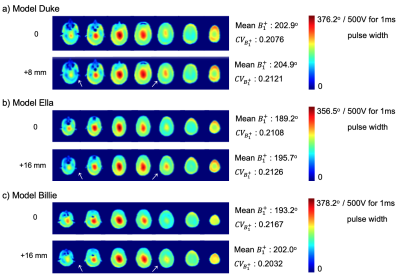 |
144 |
Investigating the impact of head position on the spatial
distribution of B1+ field for a 60-ch Tx coil at 7T
Hecheng Jin1,
Andrea N Sajewski1,
Tales Santini1,
Tiago Martins1,
Jacob P Berardinelli1,
Anthony DeFranco1,
Howard J Aizenstein1,
and Tamer S Ibrahim1
1University of Pittsburgh, Pittsburgh, PA, United States Keywords: High-Field MRI, Simulations, Head position, B1+ field, 7T MRI In this work, we computationally and experimentally evaluated the B1+ field and SAR generated by a 60-channel Tic-Tac-Toc RF coil at 7T MRI scanner on a variety of participants, head models and head positions. On three anatomically detailed human head models, we found slight changes in the intensity and the distribution of B1+ field and SAR over the whole brain when the head was moved out from the top of the coil. This was confirmed in both simulation and experimental B1+ maps. Our results highlighted the impact of imaging setup on imaging quality. |
|
4075.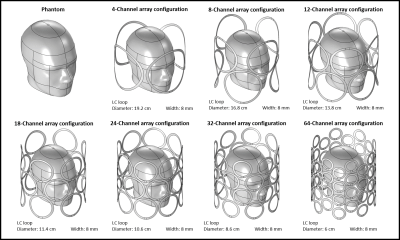 |
145 |
Investigating the Optimal Number of Channels in an Array System
for Human Head Imaging at 7T
Aditya Ashok Bhosale 1,
Leslie Ying1,
and Xiaoliang Zhang1
1Department of Biomedical Engineering, State University of New York at Buffalo, Buffalo, NY, United States Keywords: High-Field MRI, RF Arrays & Systems To determine the optimal number of channels employed in an array system for Human Head imaging at 7T, we examined different multi-channel circular LC loop array systems, ranging from 4-channel to 64-channel arrays. |
|
4076.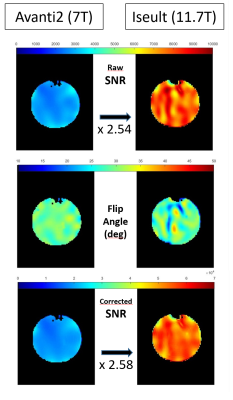 |
146 |
Preliminary SNR comparison between the 11.7T Iseult RF coil and
its twin coil at 7T
Alexis Amadon1,2,3,
Vincent Gras1,2,3,
Edouard Chazel1,2,3,
Paul-François Gapais1,2,3,
Franck Mauconduit1,2,3,
Alexandre Vignaud1,2,3,
Nicolas Boulant1,2,3,
and Michel Luong2,4
1NeuroSpin, CEA, Gif-sur-Yvette, France, 2Paris-Saclay University, Gif-sur-Yvette, France, 3Baobab, CNRS, Gif-sur-Yvette, France, 4IRFU, CEA, Gif-sur-Yvette, France Keywords: High-Field MRI, High-Field MRI, 11.7T, Signal-to-Noise Ratio The Iseult coil, developed for MRI of the human brain at 11.7T, was presented at last year’s ISMRM meeting. Here we show SNR phantom measurements in comparison with the Avanti2 coil, a replica of the Iseult coil tuned at 300 MHz (for 7T). We derive a new power dependence of the SNR vs B0. |
|
4077.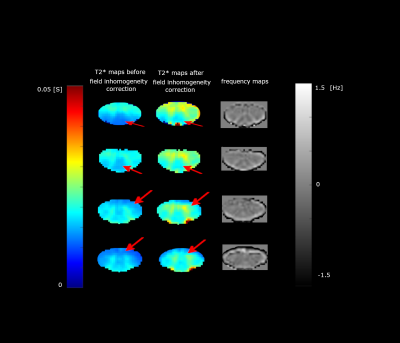 |
147 |
Background Field Inhomogeneity Correction for High-Resolution
T2* Mapping of the Human Cervical Spinal Cord at 7T
Seyedeh Nasim Adnani1,2,
Sultan Zaman Mahmud1,2,
Thomas S. Denney1,2,
and Adil Bashir1,2
1Department of Electrical and Computer Engineering, Auburn University, Auburn, AL, United States, 2Auburn University MRI Research Center, Auburn University, Auburn, AL, United States Keywords: High-Field MRI, Spinal Cord, T2* mapping, Artifacts Ultra-high-field (UHF) Spinal Cord (SC) imaging could be helpful in detecting subtle pathological changes in the human SC. The increased effect of magnetic field inhomogeneity at UHF on T2* renders the quantification unreliable. Therefore, the field correction methods are critical. We have demonstrated the application of the Voxel Spread function method, to address this issue in human SC at 7T. F-term correction was applied to the pre-processed SC images, and the T2* values were reported for SC GM and WM both before and after field inhomogeneity correction. VSF reduces magnetic field inhomogeneity effects for quantitative T2* mapping in human SC. |
|
4078.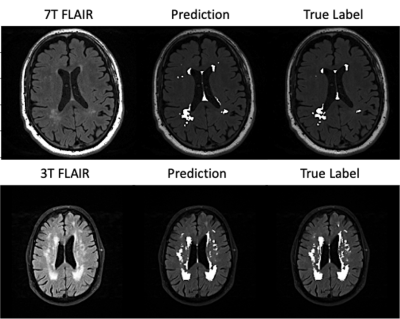 |
148 |
7T to 3T domain adaptation in white matter lesion segmentation
on T2-weighted (T2-w) FLAIR images using deep learning
Jinghang Li1,
Eduardo Diniz2,
Taylor Forry3,
Tamer Ibrahim1,4,
Howard Aizenstein1,4,
and Minjie Wu4
1Bioengineering, University of Pittsburgh, Pittsburgh, PA, United States, 2Electrical and Computer Engineering, University of Pittsburgh, Pittsburgh, PA, United States, 3Temple University, Philadelphia, PA, United States, 4Psychiatry, University of Pittsburgh, Pittsburgh, PA, United States Keywords: High-Field MRI, Machine Learning/Artificial Intelligence In this work, we explored the domain adaptation problem in deep learning segmentation. Specifically, we applied the residual U-net [1] on 3T and 7T Fluid Attenuated Inverse Recovery (FLAIR) images to delineate the white matter hyperintensity (WMH) in a 2D fashion. We leveraged learning without forgetting [2] to regulate the network’s learning in the new domain to preserve the model’s performance on the old domain while still achieving satisfying results on the new domain images. |
|
4079.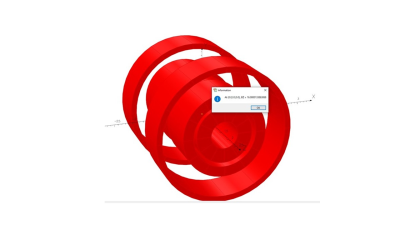 |
149 |
Compact 16T MRI Magnet: Feasibility Study and Risk Reduction
Minfeng Xu1,
Steve Buresh1,
Anbo Wu1,
Shike Huang1,
and Thomas Foo1
1Global Research, General Electric, Niskayuna, NY, United States Keywords: High-Field MRI, Magnets (B0), Superconducting Magnet; 16 T An electromagnetic design of a 16.0 T MRI magnet using a combination of Nb3Sn and NbTi superconductors has been completed. It consists of a 9.0 T inner Nb3Sn solenoid and a set of outer NbTi coils that produces 7.0 T field, for a combined 16.0 T field. The design revealed very high hoop tensile and axial compressional stresses in the Nb3Sn coil. Alloy-reinforced high-strength Nb3Sn wires were selected for use in this project. For a magnet to operate in a persistent mode, superconducting joints between Nb3Sn wire segments need to be developed. Various joint configurations were attempted with some success. |
|
4080.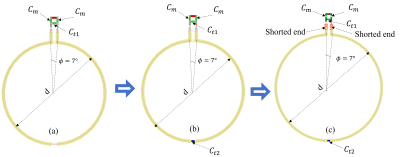 |
150 |
Design of dual-band Coaxial‐transmission‐line coils with
independent tuning capabilities
Komlan Payne1,
Aditya A. Bhosale1,
Yunkun Zhao1,
and Xiaoliang Zhang1
1Department of Biomedical Engineering, University at Buffalo, Buffalo, NY, United States Keywords: High-Field MRI, Multimodal Recently, intensive research has been conducted on coaxial‐transmission‐line (CTL) RF coils for nuclear magnetic resonance (NMR) at frequency ranging from high field to ultra-high field. The flexibility of CTL is to some extent required to image dynamic anatomy of the human body. Analysis on the CTL coils based on transmission line theory has revealed multimode operating frequency. Consequently, CTL coils can be useful to implement dual-nuclear RF coil resonator designed for Magnetic Resonance Imaging (MRI) and Magnetic Resonance Spectroscopy (MRS). In this abstract, we design a dual-band CTL with independent tuning capabilities. |
|
4081.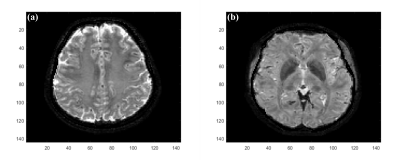 |
151 |
Bilateral Orthogonality Generating Acquisitions Method for
Homogeneous T2* Images Using Dual Channel Parallel Transmission
at 7T
Celik Boga1 and
Anke Henning1
1UT Southwestern Medical Center, Dallas, TX, United States Keywords: High-Field MRI, RF Pulse Design & Fields The T2*contrast specifically benefits from 7T human MRI systems and is frequently used in Neuroimaging. However, B1+ and B0 inhomogeneity at 7T limits the effectiveness of the T2*. A method originally proposed to minimize channel effects in the field of telecommunications, was adopted to a dual channel parallel transmission (pTx) human 7T MRI system. Final images are obtained by the unique combination of four small angle GRE acquisitons with adjusted flip angles for each channel. The proposed method is easy to implement, robust and provides homogeneous T2* images of the whole brain. |
|
4082.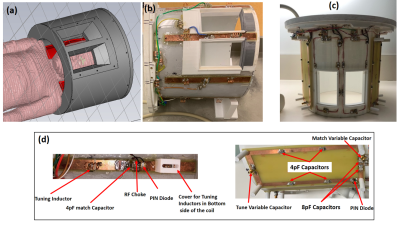 |
152 |
Evaluation of 8-Channel Transmit Dipoles and 8-Channel Transmit
Loops for Pediatric Visual Cortex Imaging at 7T
Pedram Yazdanbakhsh1,2,
Christian Sprang1,3,
Marcus Couch4,
Richard Hoge1,2,3,
Christine Lucas Tardif1,2,3,
and David A. Rudko1,2,3
1McConnell Brain Imaging Centre, Montreal Neurological Institute, McGill University, Montreal, QC, Canada, 2Department of Neurology and Neurosurgery, McGill University, Montreal, QC, Canada, 3Department of Biomedical Engineering, McGill University, Montreal, QC, Canada, 4Siemens Healthcare Limited, Montreal, QC, Canada Keywords: High-Field MRI, RF Arrays & Systems An 8-channel transmit radiofrequency (RF) coil array consisting of eight dipoles and another 8-channel transmit coil array consisting of 8-loops were designed, constructed and compared with each other for pediatric (4-9 years old) visual cortex imaging at 7T. To ensure robust safety of the 7T parallel-transmission (pTx) coil, local SAR matrices and the commensurate virtual observation points (VOPs) has been calculated for online SAR supervision. An 8-channel receive only array consisting of eight overlapped loops covering the back of the pediatric head area has been constructed and used inside the transmit coils for visual cortex imaging. |
|
4083.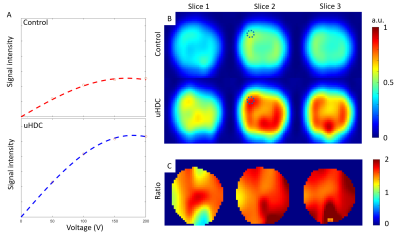 |
153 |
Significant Signal-to-Noise Ratio (SNR) Enhancement with
Ultrahigh Dielectric Constant (uHDC) Ceramic Disks for 2H MRSI
Application at 7T
Soo Han Soon1,2,
Hannes M. Wiesner1,
Xin Li1,
Michael T. Lanagan3,
Qing X. Yang4,
Xiao-Hong Zhu1,
and Wei Chen1,2
1Center of Magnetic Resonance Research (CMRR), Department of Radiology, University of Minnesota, Minneapolis, MN, United States, 2Department of Biomedical Engineering, University of Minnesota, Minneapolis, MN, United States, 3Department of Engineering Science and Mechanics, Pennsylvania State University, University Park, PA, United States, 4Center for NMR Research, Department of Neurosurgery and Radiology, College of Medicine, Pennsylvania State University, Hershey, PA, United States Keywords: High-Field MRI, New Devices, Ultrahigh dielectric constant material (uHDC) Ultrahigh-field (UHF) deuterium (2H) magnetic resonance spectroscopy imaging (DMRSI) is valuable to study neuroenergetics by quantitatively measuring the energy metabolic rates in the human brain. However, the low intrinsic signal-to-noise ratio (SNR) of deuterium signal due to its low gyromagnetic ratio and low metabolites concentration has been a technical challenge to achieving high imaging resolution. In this study, we have integrated ultrahigh dielectric constant (uHDC) ceramic disks with an 8-channel 2H-1H human head array coil to largely improve the receive sensitivity and DMRSI SNR (>60%) at 7T, aiming for human brain metabolic imaging application. |
|
4084.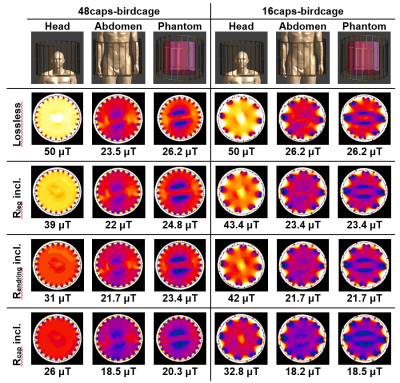 |
154 |
Understanding Loss Mechanisms in Double-Tuned Body Coils To
Improve B1 Efficiency
Busra Kahraman-Agir1,
Dimitri Welting1,
Mark Gosselink1,
and Dennis Klomp1
1Department of Radiology, University Medical Center Utrecht, Utrecht, Netherlands Keywords: High-Field MRI, Non-Array RF Coils, Antennas & Waveguides, multinuclei body coils, double tuned Double-tuned circuits are often comprised of internal resonances in tank circuits that locally may amplify RF currents and thereby cause extra loss compared to single tuned RF coils. Here, we investigated the loss mechanisms of RF borecoils for the operating frequencies of 120.68, 78.8 and 45.8MHz for the purpose to design a B1+ efficient multi-tuned RF borecoil for metabolic MRI of 2H, 23Na and 31P, respectively at 7T.
|
|
4085.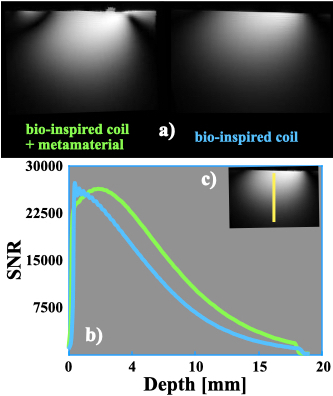 |
155 |
Enhancing performance of a bio-inspired surface coil wtih a
flexible metasurface for preclinical MRI at 7 T
Sergio Solis-Najera1,
Jelena Lazovic2,
Fabian Vazquez1,
Rodrigo Martin1,
and Alfredo Odon Rodriguez3
1Departamento de Fisica, UNAM, Mexico City, Mexico, 2Department of Physical Intelligence, Max Planck Institute for Intelligent Systems, Stuttgart, Germany, 3Electrical Engineering, UAM Iztapalapa, Mexico City, Mexico Keywords: High-Field MRI, Non-Array RF Coils, Antennas & Waveguides, metamaterials A bio-inspired surface coil was built for preclinical MRI applications at 7 T. Images were acquired with and without a flexible metasurface partially cover a cylindrical phantom. Images obtained with the metamaterial showed an important improvement of coil performance. No electronic components were used for tuning the metasurface. This easy-to-implement approach offers an alternative to improve the SNR for preclinical applications at high field. |
|
4086.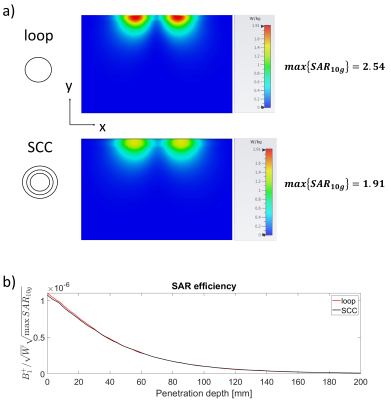 |
156 |
Exploration of the shielded-coaxial-cable coil as transceive
array element for 9.4T MRI
Giovanni Costa1,
Margarethus Maarten Paulides1,
and Irena Zivkovic1
1Department of Electrical Engineering, Technical University of Eindhoven, Eindhoven, Netherlands Keywords: High-Field MRI, High-Field MRI, RF arrays, transcieve coils, SCC coil The recently proposed shielded-coaxial-cable (SCC) coils are intrinsically highly decoupled elements. Their suitability in multichannel transceiver arrays at ultra-high field was successfully demonstrated in 7T arrays. In this work, we investigated the single element and array properties of SCC coils at 9.4T. We simulated the SCC element and compared its properties (B1+, SAR) with those of a conventional loop coil. Subsequently, we fabricated eight SCC coils and investigated their coupling properties when placed in various configurations. SCCs at 400MHz provided similar B1+ and SAR efficiency, but generated ~25% less SAR10g,max . SCC performed well in different array configurations. |
|
4087.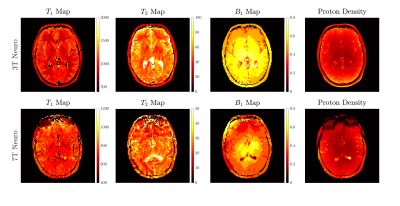 |
157 |
A Comparison of Cartesian MR Fingerprinting Maps acquired at 3T
and 7T
Saba Shirvani1,
Belinda Ding2,
and Christopher T. Rodgers1
1Clinical Neurosciences, University of Cambridge, Cambridge, United Kingdom, 2Research and Collaboration UK, Siemens Healthcare Ltd, Frimley, United Kingdom Keywords: High-Field MRI, High-Field MRI, body, mr fingerprinting, tissue characterization Abdominal 7T MRI is technically demanding but has great potential due to improved signal-to-noise ratio. One promising way to quantify tissue properties is to use MR Fingerprinting, since MRF rapidly quantifies T1 relaxation alongside other tissue properties such as T2, B1+ and proton density. However, translating MRF measurements from high field to ultra-high field systems is challenging. Here we investigate a strategy to translate a Cartesian MRF sequence from 3T to 7T scanners, by optimising sequence parameters. We apply this approach to the brain and to the kidney and present comparable images from our 3T and 7T scanners. |
|
4088.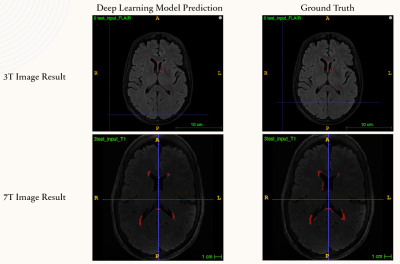 |
158 |
3D Deep Learning Segmentation of White Matter Hyperintensity on
3T and 7T Brain MRI Scans
Yuanzhe Huang1,
Jinghang Li1,
Linghai Wang1,
Taylor Forry2,
Tamer Ibrahim1,
Howard Aizenstein1,
and Minjie Wu1
1University of Pittsburgh, Pittsburgh, PA, United States, 2Temple University, Philadelphia, PA, United States Keywords: High-Field MRI, Machine Learning/Artificial Intelligence White matter lesions (WMLs), commonly found as hyperintensities (WMHs) on T2-weighted FLAIR MR brain images, are associated with neuropsychiatric and neurodegenerative disorders. In the present study, we adapted a 3D U-Net deep learning method to automatedly segment the WMHs on 3T and 7T MRI T2w FLAIR brain images. Using 3D U-Net, the accuracy of WMH segmentation is 98.8% for 3T data, while it drops to 90.3% for 7T data. However, after incorporating histogram matching in the preprocessing, the accuracy of WMHs segmentation significantly improves to 97.5% for 7T data. |
|
4089.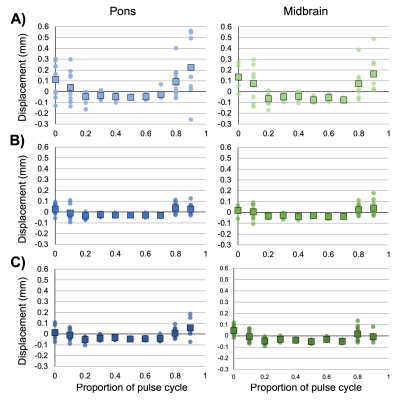 |
159 |
Effects of spatial resolution on brain tissue displacement
estimates based on DENSE MRI at 7T
Amelia Strom1,2,
Timothy G. Reese2,3,
Zijing Dong2,3,
Baarbod Ashenagar4,
Laura D. Lewis2,4,
and Jonathan R. Polimeni1,2,3
1Health Sciences and Technology, Massachusetts Institute of Technology, Cambridge, MA, United States, 2Athinoula A. Martinos Center for Biomedical Imaging, Massachusetts General Hospital, Charlestown, MA, United States, 3Department of Radiology, Harvard Medical School, Boston, MA, United States, 4Department of Biomedical Engineering, Boston University, Boston, MA, United States Keywords: High-Field MRI, Tissue Characterization, Neurofluids, Diffusion Imaging Techniques Displacement Encoding with Stimulated Echoes (DENSE) MRI was used to estimate pons and midbrain tissue displacement over the cardiac cycle at 2-mm, 3-mm, and 4-mm isotropic spatial resolutions in individual subjects at 7T. Displacement estimates were largest at 2-mm resolution and matched previous reports of peak brainstem displacement over the cardiac cycle. Smaller estimates at lower resolution may be due to partial volume effects from the surrounding tissue or CSF. |
|
4090.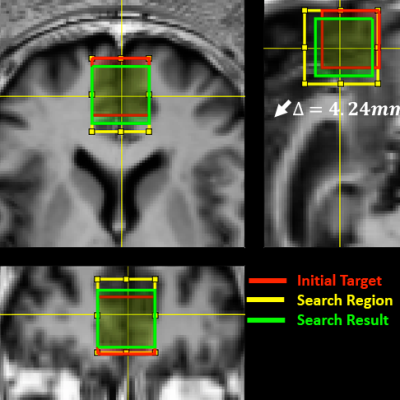 |
160 |
Susceptibility Managed Optimization (SUMO) : Very HIgh order
shimming for Single Voxel Spectroscopy at 7T
Hoby Hetherington1,
Junghwan Kim2,
Melissa Terpstra2,
and Jullie Pan2
1Resonance Research Inc., Billerica, MA, United States, 2Radiology, University of Missouri, Columbia, MO, United States Keywords: Shims, Shims B0 shimming for single voxel spectroscopy (SVS) is of importance due to its role in determining linewidth, accuracy of the analysis and interpretation. However, for difficult brain regions, such as the prefrontal cortex, where shifts of 3-6mm in voxel position can dramatically alter the achieved linewidth in SVS, the lack of a reliable method to predict the achievable homogeneity results in failed studies and/or increased study times. In this work we demonstrate an objective and non-iterative method (SUMO) for voxel positioning that predicts and ensures adequate B0 homogeneity is achievable. |
|
The International Society for Magnetic Resonance in Medicine is accredited by the Accreditation Council for Continuing Medical Education to provide continuing medical education for physicians.